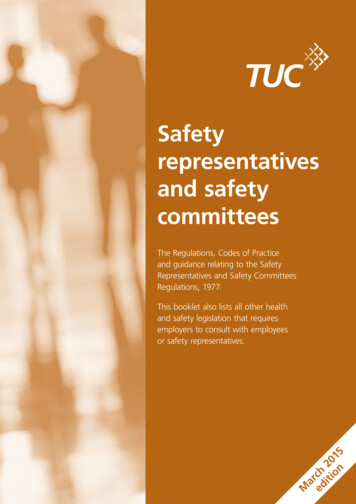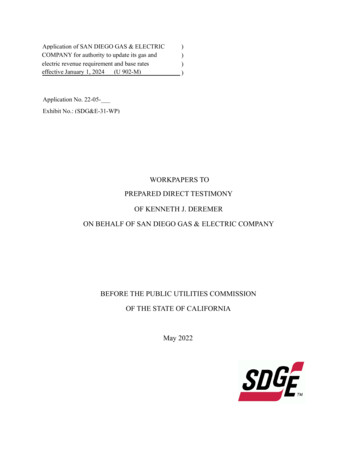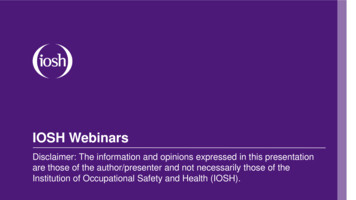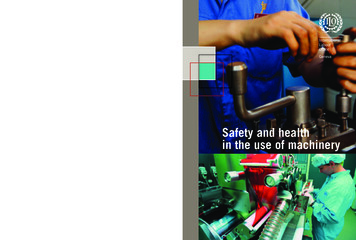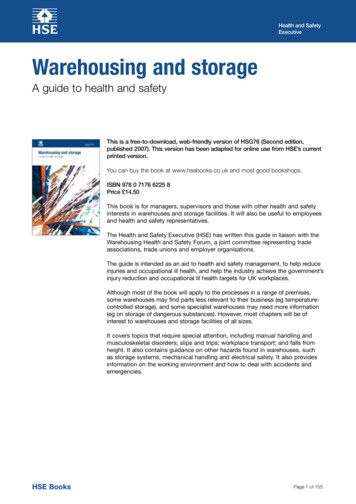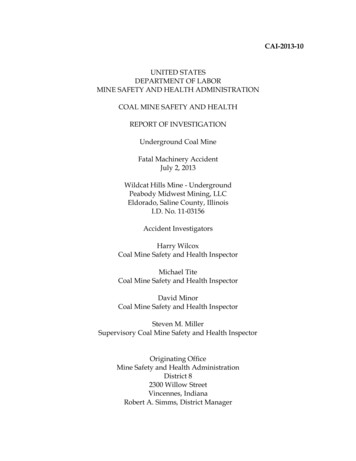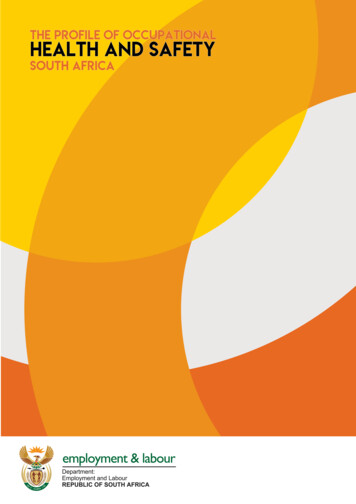
Transcription
The Profile of OccupationalHealth and SafetySouth Africa
THE PROFILE OFOCCUPATIONAL HEALTH AND SAFETYSOUTH AFRICA
The Profile of Occupational Health and SafetySouth AfricaA project commissioned jointly by the International Labour Organisation and the Department of Employment and Labour, South AfricaPretoria, 2020Authors:Sibongiseni S Myeni (DBA, MBA, MMedSc, BSc Hons, BSc), SeniNhle Occupational Health Services.Ntombenhle J Ngcobo (MBChB, MScMed, MBA, DOH, DTM&H, DCH), SeniNhle Occupational Health Services.Copyright Department of Employment and Labour South Africa and the International Labour Organization.
ACKNOWLEDGMENTSThe authors express sincere gratitude to the Inspectorate and Enforcement Services Branch of the Department of Employment and Labour andtheir efficient office. We are indebted to the Chief Inspector, Mr Tibor Szana and Ms Bulelwa Huna, for their insightful comments in reviewingthe initial draft of this report, their support with providing key information as well as in facilitating communication with the stakeholders.Our sincere gratitude to Mr Phumi Maphaha, Mr Jacob Malatse and all staff members at the Department of Employment and Labour for theiravailability and facilitating access to information.We are grateful to the members of the Advisory Council for Occupational Health and Safety for initiating this process and for their guidanceand support during the data collection process.We express our gratitude to ILO South Africa Office and ILO Eastern Africa Office and especially the OSH Specialist, Ms Penny Munkawa for herguidance and support in compiling this document as well as inputs in the earlier drafts of the report.We sincerely thank all the stakeholders and everyone who participated in the interviews and made contributions by responding to thequestionnaires that were sent to them. We appreciate their time in being part of this process and mindful of the fact that this report wouldnot have been without their highly valued inputs and insights.
FOREWORDOccupational health and safety in the Republic of South Africa is more than a century old with inspectors operating in health and safetytowards the end of the 19th century. This coincided with the rapid development of the industry after the discovery of diamonds in the 1860’sand the discovery of gold in the 1880’s.This naturally gave rise to the 1st Industrial revolution in South Africa moving from what was largely an agrarian society at the time. At thattime, South African was a colony of the United Kingdom. As a result, the systems in health and safety that were developed in the UK, wereintroduced to its colonies. All the required policies were then developed and introduced. Even though the first health and safety policy focusedon safety as espoused by the Machinery and Occupational Safety Act no 6 of 1983 (MOS Act), we went on to recognise the importance ofhealth at the workplace. As the saying goes “a health workplace is a safe workplace” whereas, a safe workplace is not necessarily a healthyworkplace. It was out of this realisation that the OHS Act was borne.Decades later, I became an inspector. I was able to experience first-hand what it was like working on the ground, having to protect the mostvulnerable of workers by ensuring decent work was a reality for them. After doing many, many inspections, I was able to put it into practice allthe valuable lessons when I was responsible for developing policy after I became Chief Inspector several years laterWe are now on the cusp of the development of the fifth OHS Act (currently in Bill form) which I believe will revolutionise the current healthand safety practises and offers greater protection for workers, while equally protecting complying employers. This Bill was the culminationof years of stakeholder and partner interaction at NEDLAC. The Bill has been approved for public comment by the Cabinet of South Africa.South Africa, through the Department of Employment and Labour (IES: Health and Safety), has always enjoyed a strong relationship with theILO. I had the privilege of ensuring that South Africa became a signatory to Labour Inspection Convention, 1947 (No.81).This document that you have in your hands is a valuable document in that it is the first of its kind. It is not just about occupational health andsafety for which the Department of Employment and Labour is responsible, it covers all aspect of occupational health and safety in SouthAfrica.This document is a culmination of work done by all government departments and entities, both statutory and non-statutory institutions thatare responsible for occupational health and safety in South Africa.I would like to recognize the following key role players in the development of this document:The ILO, for funding the project and playing a significant role in its development. Dr Sibongiseni Myeni: Occupational Hygienist and Leadership Specialist (DBA, MBA, MMedSc, BSc Hons) Dr Ntombenhle Ngcobo : Occupational Medical Practitioner (MBChB, MScMed, MBA, DOH, DTM&H, DCH)In conclusion, I commend the Inspector General, Aggy Moiloa, and her team on the work done in ensuring that this project was driven to asuccessful conclusion.Thobile Lamati (Mr)Director General: Employment and LabourRepublic of South Africa07 June 2021
PREFACEWe present to you, the National Occupational Health and Safety (OHS) profile. This document has been long in the marking. The realisationthat something needs to be done around consolidation of OHS relate processes has long been then. The task was daunting for the longest oftime, but when we finally delved into it, we did not hold back.The forthcoming pages are rich with potential. You will notice that quite a bit of space is provided to reflecting on the legal framework of OHS.Both local and international lawful building blocks were considered to a large extent. This includes laws, regulations, directions, conventions,recommendations and standards.An observation should be made that at the centre of this national profile of OHS, are the intended beneficiaries. It should not be misconstruedthat these are just limited to the human element. It can be argued that a sound national OHS profile would bode well for the health of theeconomy as well. This is not meant to underplay the socio-economic impact of this but to simple state that our thinking should be opened tothe convolution of economic and human health.You will perceive that this national profile cannot be complete without a reflection on the operational environment, which is effectively madeup of systems, processes and people. To give credence to meaningful implementation and application of safety and health related standardsand practices, it is rather obvious that the operational environment cannot be underplayed.Various stakeholders came together to present with an opportunity of rich engagements and consultations. This includes: various governmentdepartments, state agencies and entities, research and academic institutions as well as standard setting bodies, Each played an indispensablerole towards the putting together of this profile.This document is a first of its kind. There’s little doubt that this is an exciting opportunity as it offers a leverage for future like initiatives.Happy reading.Ms Aggy MoiloaInspector General: Inspections and EnforcementDepartment of Employment and LabourSouth AfricaJune 2021
CONTRIBUTORSCompetent authorities and institutions African Union Development Agency-New Partnership for Africa’s Development Department of Employment and Labour Department of Health: Medical Bureau for Occupational Diseases and Compensation Commissioner for Occupational Diseases Department of Mineral Resources and Energy International Labour Organization National Institute for Occupational Health South African Bureau of Standards South African Maritime Safety Authority South African National Accreditation System South African Police Service - ExplosivesProfessional bodies Employee Assistance Professionals Association of South Africa Ergonomics Society of South Africa Health Professions Council of South Africa Institute of Working at Height Mine Medical Professionals’ Association Southern African Institute for Occupational Hygiene South African Institute of Occupational Health and Safety South African Society of Occupational Health Nursing Practitioner South African Society of Occupational Medicine South African Qualification & Certification Committee Fire South African Qualification & Certification Committee Gas
TABLE OF CONTENTSEXECUTIVE SUMMARYIX1. INTRODUCTION12. METHODOLOGY23. FINDINGS FROM IN-DEPTH INTERVIEWS24. NATIONAL REGULATORY FRAMEWORK64.1. Laws and Regulations64.1.1 The Constitution64.1.2 Laws, Regulations and Collective Bargaining on OSH94.1.3 Laws and Regulations Related to OSH Under Other Ministries124.1.4 ILO Conventions Ratified by South Africa.134.1.5 Legislation on Gender Equality and Non-discrimination134.1.6 Application of International Standards154.1.7 Legislation Cognisance of Biological Differences164.1.8 Legislation on Sectors and Occupations Where Women and Men Work.164.1.9 COVID-19 Pandemic and OSH Related Law Reform.174.2 OSH Technical Standards, Guidelines and Management System174.2.1 OSH Management System174.2.2 Emergency Prevention, Preparedness and Response174.2.3 Workplace Emergency Arrangements with Emergency Service185. INSPECTION AND ENFORCEMENT SYSTEMS185.1 Inspection Methodology and Powers of Inspectors185.2 Department of Employment and Labour (DEL) Inspectorate215.3 Department of Mineral Resources and Energy Inspectorate225.4 Department of Transport235.5 Department of Safety and Security235.6 National Nuclear Regulator235.7 Inspectors participation in training and advisory services.246. CONSULTATION, COORDINATION AND COLLABORATION MECHANISMS246.1 Consultation and Collaboration at National Level246.1.1 The National Economic Development and Labour Council266.1.2 The Advisory Council for Occupational Health and Safety266.1.3 The Mine Health and Safety Council276.1.4 Collective Bargaining Councils276.2 Collaboration at Enterprise Level276.2.1 Collective Bargaining Agreements276.2.2 Occupational Health and Safety Committees276.3 Business Response to Emergency and Disasters27
7. NATIONAL REVIEW MECHANISMS288. EDUCATIONAL, TRAINING AND AWARENESS RAISING STRUCTURES298.1 University and College Courses Related to OSH298.2 Categories of Health and Safety Professionals and courses298.3. National Information Centres and OSH Advisory Services328.4 Training Conducted by Employers and Employers Organisation328.5 Institutions Conducting Legally Required Training for OSH Specialists338.6 Link and Collaboration with Regional and International Networks.339. OCCUPATIONAL HEALTH SERVICES349.1 Occupational Medicine in terms of the OHSA349.2 Occupational Medicine under the MHSA349.3 National Institute for Occupational Health349.4 Occupational Health in terms of SAMSA and SACAA359.5 Occupational Hygiene3510. OCCUPATIONAL HEALTH AND SAFETY LABORATORIES3611. SOCIAL SECURITY, INSURANCE AND COMPENSATION SERVICES3811.1 The Compensation Fund Under COIDA3811.2 The Compensation Fund Under ODMWA3811.3 COVID-19 Compensation3812. STATISTICS OF OCCUPATIONAL ACCIDENTS AND DISEASES3912.1 Recording and Notification of Occupational Injuries and Diseases3912.2 Compensation Claims to the DEL3912.3 Occupational Injuries and Diseases4112.4 Occupational Injuries and Diseases at the Mines4512.5 Compensation for Mine Workers Under ODMWA4613. NATIONAL LEVEL OF HUMAN RESOURCES ACTIVE IN OSH4713.1 Different Categories of OSH Professionals4713.2 Gender Differences4914. POLICIES, PROGRAMS OF EMPLOYERS AND WORKERS’ ORGANISATIONS5115. REGULAR AND ONGOING ACTIVITIES RELATED TO OSH5316. INTERNATIONAL COOPERATION5417. PROMOTION OF ELIMINATION PROGRAMMES5518 PREVALENCE AND RESPONSE TO COVID-195718.1 Summary on Extent of COVID-19 and Specific Sectors19. GENERAL COUNTRY DATA19.1 Demographic Data575959
20. ECONOMIC DATA20.1 Gross Domestic Product636321. OTHER RELEVANT INFORMATION6422. OTHER RELATED ISSUES6422.1 Policies that may Impact on OSH Development and Delivery Systems6422.2 OSH Issues on International Trade that may Impact on the Country6423.SPECIALISED TECHNICAL, MEDICAL AND SCIENTIFIC INSTITUTIONS6423.1 Poison Centers6423.2 Standardising Bodies6423.3 Institutions Specialised in Occupational Hazard and Risk Assessment6523.4 Emergency Preparedness, Warning and Response Services6524. SITUATIONAL ANALYSIS AND RECOMMENDATIONS6624.1 Legislative Framework6624.2 Occupational Health and Safety Professional Bodies and Associations6724.3 Main Strong Points6724.4 Weaknesses and Gaps of the System6724.5 Infrastructure6724.6 Skills and Capacities6724.7 Gender and Informal Economy6724.8 Preparedness and Response to Pandemics and COVID-1968RECOMMENDATIONS71BIBLIOGRAPHY72
xEXECUTIVE SUMMARYSouth Africa has a long history on occupational safety and health(OSH), including related legislation that goes back to the late1800s. With South Africa’s long mining history, OSH and associatedlegislation evolved from the mining industry and resulted in differentpieces of legislation under three Departments.THE PROFILE OF OCCUPATIONAL SAFETY AND HEALTHThe challenges brought by this situation and other challengesincluding the loss of lives in the workplace, particularly in the mines,prompted the setting up of commissions of enquiry into OSH, relatedlegislation, and regulations. It is worth noting that prior to 1994,the hallmark of OSH compensation benefits was race-based. Thecommissions included the Leon Commission of 1994, which greatlyshaped OSH in the mining industry and was the basis of the MineHealth and Safety Act of 1996. The Benjamin and Greef Committeeof Inquiry into OSH of 1997 came up with recommendations aimedat addressing the fragmentation in OSH legislation. The CabinetMemorandum 1 of 1999 gave the Department of Employment andLabour (DEL) a mandate to lead a process of integration of OSHlegislation, which set a stage for the development of the draft OSHPolicy in 2003.Unfortunately, most of the Commissions and Committeerecommendations were not implemented. Consequently, SouthAfrica remains with the 4 main pieces of legislation on OSH under3 different departments: the Occupational Health and Safety Act(OHSA) and the Compensation for Occupational Injuries and DiseasesAct (COIDA) under the DEL; the Mine Health and Safety Act (MHSA)under the Department of Mineral Resources and Energy (DMRE); andthe Occupational Diseases in Mines and Works Act (ODMWA) underthe Department of Health (DoH).As a member of the International Labour Organization (ILO), SouthAfrica has an obligation to develop a national OSH policy and anational OSH strategy. It is in this background that the DEL initiatedthe process of developing an OSH profile for SA. The ILO Convention187 is of particular importance for this process because it providesguidance on the establishment of OSH systems and outlines theimportance of the development of a country OSH profile.The methodology that was followed in developing this OSH profileis twofold: literature review and primary data collection. Documentsreviewed were the legislation; annual reports of governmentdepartments and stakeholders; reports and other publications frominstitutions and stakeholders; websites and peer reviewed articles.Customised questionnaires were developed and used to collectqualitative and quantitative primary data. Questionnaires thatcontained both qualitative and quantitative questions were widelycirculated to stakeholders. A semi-structured interview guide wasused to collect qualitative data through in-depth interviews with 34purposively selected participants, representing 7 stakeholder groups.The thematic analysis of qualitative data from the interviews pointedto the following:Legislation: Although progressive, legislation is fragmented,complicated and it generally excludes informal economy anddomestic workers. Fragmentation results in inefficient use of limitedresources. Legislation is viewed as punitive.Government’s role in OSH is perceived to be a setback in thatgovernment departments are significant defaulters and are noncompliant with OSH legislation. Government departments thatregulate OSH work in silos, with little coordination and collaboration.The level of awareness on OSH and reporting was viewed to be pooramongst government employees. There is a general lack of reportingof work-related injuries and diseases in the public sector.Work related injuries and diseases data collection and reportingis fragmented and not harmonised among and within the differentdepartments. There is no uniform way of recording and reportinginjuries and diseases statistics. Therefore, there is no clear picture ofthe burden of OSH injuries and diseases.Enforcement of legislation is perceived as a challenge with poorcompliance by employers and serious limitations with humanresources capacity for inspections. Enforcement is generally reactive.Suggestions by participants included that the process of reviewinglegislation should be fast tracked and that the South African LocalGovernment Association should support OSH systems and providebasic facilities for informal economy workers to promote OSH.Findings from quantitative data point to good efforts in inspections bythe DEL with little human resources. In 2019 over 28 000 inspectionswere conducted with less than 300 Inspectors. Recently created postsincreased the number of Inspectors to 778 (533 currently filled).According to the 2020 Quarter 2 Quarterly Labour Force Survey, thepopulation of employed people in South Arica is 14,148 million and455 000 of these people are employed in the mines. The inspector toemployee ratio will be 1 inspector for 17 600 employees, provided ifall the 778 posts are filled.Inspections show poor compliance by wholesale and retail sectorand the construction sector. The wholesale and retail sector recordsthe highest number of Compensation Fund claims, which exceedseven the police and the security services. Iron and steel industryalso has a high number of incidents. The monetary value of claimsto the Compensation Fund under DEL has been rising over the years.In 2016/17 it was just over R 4 billion. It is noteworthy that medicalcosts account for 66% to 71% of these claims.Mining Industry reports that injuries are declining. There were 3 036injuries in 2015 and 2 350 in 2018. This amounts to a rate of 1 incidentper 150 employees per year. Fatalities have stagnated between 71 in2014 and 81 in 2018 with a peak of 90 in 2017.There is no National OSH policy and strategy. Acts on OSH that areunder review include the COID Amendment Bill and OccupationalHealth and Safety Amendment Bill. The ILO Committee of Expertson the Application of Conventions and Recommendations and thestakeholders have noted the long time it takes to amend legislation.It is recommended that the country should develop a national OSHpolicy and a strategy; revive, contextualise, and implement theCabinet Memorandum 1 of 1999; integrate OSH competencies;prioritise and fast track the process of reviewing legislation;implement the articles of the ILO Conventions when reviewinglegislation; consider the role of the South African Local GovernmentAssociation and Municipalities in OSH; inform the cabinet (allMinisters) of the findings of this report, with the focus on the noncompliance of the public sector structures with OSH legislation andelicit high level commitment to addressing this; capitalize on theopportunities brought by COVID-19 to advocate for and instil an OSHculture across all sectors in the public and private sector.
11. INTRODUCTIONTHE PROFILE OF OCCUPATIONAL SAFETY AND HEALTHOccupational safety and health legislation in South Africa dates tothe late 1800s, with the Precious Stones and Mineral Mining RightsAct of the Cape of Good Hope, Act 19 of 1883 that mentioned‘the protection of life and limb’. However, it was the Phthisis Act,Act 34 of 1911 (PA), directed at the mining industry, that focusedon occupational health. It also introduced compensation for Whiteworkers, suffering from phthisis. The PA was in response to theconcern about the high number of mine workers that acquiredsilicosis and tuberculosis as a result of living and working conditions.The PA was replaced by the Mines and Works Act, Act 12 of 1911(MWA 1911) which was amended a number of times up to the Minesand Works Act, Act 27 of 1957 (MWA 1957). This was replaced bythe Minerals Act, Act 50 of 1991 (MA), which in turn replaced by theMine Health and Safety Act, Act 26 of 1996 (MHSA).The focus on occupational hazards and diseases was initially in themines. The Factories Act, Act 28 of 1918 (FA) was introduced about35 years after the PA. The FA focused on sectors other than the mineswhich was replaced by the Factories, Machinery and Building WorkAct, Act 22 of 1941 (FMBWA). This Act was largely on preventionof accidents. It excluded workers in the agriculture sector. TheMachinery and Occupational Safety Act, Act 6 of 1983 (MOSA), cameover 40 years later and replaced the F. It covered more on issuesof occupational safety and health and emphasis on occupationalhygiene. MOSA was replaced by the Occupational Health and SafetyAct, Act 85 of 1993 (OHSA). It is noteworthy that the OHSA is oneof the main pieces of occupational safety and health legislation andthat it dates before South Africa’s democracy and the Constitution ofthe Republic.The compensation for mine workers dates back to the PA andlater the Occupational Diseases in Mines and Works Act, Act 78 of1973 (ODMWA). Other industries only had compensation with theintroduction of the Workmen’s Compensation Act, Act 30 of 1941(WCA) in 1941. The WCA initially excluded agricultural workers anddid not cover domestic and self-employed workers. In the mines,ODMWA introduced a list of compensable diseases. It is worth notingthat all these pieces of earlier legislation had the hallmark of racialdiscrimination in the rights and benefits afforded by these Acts,which compromised the Black workers and often left them with littleor no benefits.provincial health departments in occupational health. The CabinetMemo of 1999 culminated in the draft National OHS Policy, 2003and the OH Services for Health Care Workers in the National HealthService of South Africa: A Guideline Booklet, 2003.South Africa is committed to the decent work agenda1 and adecent future of work for its citizens. The implementation of theInternational Labour Organization (ILO) conventions is key toresolving the challenge of OSH at the workplaces. South Africa isone of the 187 member states of the United Nations (UN). The ILOadopted Convention C187- Promotional Framework for OccupationalSafety and Health Convention, 2006 (No. 187)2 on 31 May 2006 andcame into force in 2009. South Africa is one of 49-member states thathave not ratified C187, which provides a framework and obligatoryelements of an OSH system, which signatory member countries mustimplement.The elements of an OSH System include the national policy, nationalsystem, national program for OSH, and the national preventivesafety and health culture. In line with C187 and ILO‘s standards,it is necessary to conduct a country assessment of the overallOSH situation. Information from the assessment provides anunderstanding of available means and most urgent need, that forma basis for the development of a strategic priority and procurementof broad political support. This should be followed by a step-by-stepdevelopment of the OSH infrastructure and the periodical evaluationof progress and adjustment in planning and execution as and whennecessary. This OSH profile for South Africa is a situational analysisof the OSH system in the country. The project was commissioned bythe Department of Employment and Labour (DEL) and the ILO. Thecountry profile is the first stage in the process of policy developmentand a national OSH strategy as described by the ILO C187.The challenges that were brought up by the different pieces oflegislation on occupational safety and health prompted the setupof Commissions to examine the state of OSH and labour reform inSouth Africa, that started prior to democracy. These include the:Erasmus Commission of 1974, Ricket Commission (1977), Wiehahn(1977) Commission, Niewenhuizen (1977) Commission, and the LeonCommission (1994). Erasmus and Leon Commission reports wereinstrumental in the repeal of the FA, enactment of the subsequentMOSA, and the current OHSA as well as the MHSA.The developments noted above, are a long history of a country thatis committed to addressing the OSH of workers in the context ofstructural challenges that stem from its history of inequalities andsocial divide of the apartheid era. Post 1993 OSH developmentsinclude the 1997 Benjamin and Greef Report of the Committee ofInquiry into a National Health and Safety Council in South Africa.An earnings-based system of lump-sum compensation paymentsreplaced the race based discriminatory ODMWA 1973 compensationsystem. In addition, the 1997 White Paper on the Transformation ofHealth Systems in South Africa provided a framework for the role of1. South Africa, Decent Work Country Programme 2018-2023. June 2018. Retrieved from https://www.ilo.org/wcmsp5/groups/public/---ed mas/---program/documents/genericdocument/wcms 674579.pdf2. International Labour Organization: Conclusions adopted by the International Labour Conference at its 91st Session, 2003 on Global Strategy on Occupational Safety and Health’and Convention No.187 - Promotional Framework for Occupational Safety and Health Convention, 2006. Retrieved 08/09/2020
22. METHODOLOGYResearch approach3. FINDINGS FROM IN-DEPTHINTERVIEWSThis section discusses key themes and insights that came out ofthe confidential, semi-structured in-depth interviews with 34purposefully selected participants. Themes were identified in theinterview responses are presented below.Secondary data Collection.Theme 1: COVID-19 OpportunitiesSecondary data were collected by conducting literature andlegislation review of: Legislation and national policy documentsParticipants highlighted that COVID-19 has revealed opportunitiesthat South Africa had not explored before. For example, duringCOVID-19, technology was used to take information quickly available.COVID-19 has also revealed the need to develop and implementdisaster management plans as part of OSH management. On theother hand, participants felt that COVID-19 provided an opportunityto see what the country could not see before. A participant put itthis way: OSH reports and peer reviewed articles OSH association and professional bodies documents Publications from key stakeholders: labour, employers,accreditation bodies, Annual reports and other sources of relevant informationPrimary Data CollectionQualitative data collection A semi-structured interview guide was used to interviewpurposefully selected individuals of key stakeholders. 34 participants, representing seven stakeholder groups:Worker Organisations, employer Organisations includinginformal economy, government departments, professionalbodies, bargaining councils, standardizing bodies and traininginstitutions participated. Semi-structured in-depth virtual interviews through zoom,prompted participants to explore and share their insights of theOSH system and its effectiveness.Quantitative data collectionA data collection instrument that contained both qualitative andquantitative questions was designed for data collection. Theinstrument included a wide range of areas: human resources for OHS;collaboration with stakeholders and international bodies, challenges;role played during COVID-19 pandemic and trends in occupationalinjuries and diseases and the review of legislation on OSH. It waswidely distributed to stakeholders.Data AnalysisQuantitative data was subjected to descriptive statistical analysis andpresented in tables and graphs. Qualitative data was subjected tothematic analysis, that was data driven. There was no attempt to fitthemes into a pre-existing theoretical framework.“With the arrival of COVID, it has brought the realization that OHShas been ignored or just a by the way issue of compliance.”Participants highlighted that during COVID-19, there was bettercooperation between stakeholders, especially between governmentand employers. One participant said.“COVID-19 helped to bring us together and to see we are all inthis together”.Theme 2: Enforcement of legislationParticipants were of the view that South Africa has good legislation.They praised the comprehensiveness of the OSH legislation. However,there is lack of enforcement.“There are certain offences that are deemed criminal but whenyou look at the current situation, I have not heard of someoneimprisoned. We never hear of successful prosecution of offencescommitted. Amend existing legislation to fill in these gaps. Andthen be seen to be active and enforce”. A participantParticipants felt that legislation took long to implement and enforce,this could be shortened by involving other parties by includinglegislation in bargaining agreement.“Detail implementation should be included in the policies and inthe main agreement. For example, a bargaining agent is to issuea compliance notice and refer to our dispute resolution centre(DRC). Allow our agents to refer to DRC instead of referring to thedepartment. We can only enforce in accordance with collectiveagreement nothing else. Main agreement”. A participantTo improve on enforcement, participants proposed that there shouldbe partnerships in enforcement through bargaining councils. Therewas also a call for enforcement of legislation to be more proactivethan reactive. They expressed a need for stakeholders to workclosely with the inspectors on OSH issues. They expressed that OSHlegislation in SA is still mainly driven by compliance and has notreached a s
EXECUTIVE SUMMARY IX 1. INTRODUCTION 1 2. METHODOLOGY 2 3. FINDINGS FROM IN-DEPTH INTERVIEWS 2 4. NATIONAL REGULATORY FRAMEWORK 6 4.1. Laws and Regulations 6 4.1.1 The Constitution 6 4.1.2 Laws, Regulations and Collective Bargaining on OSH 9 4.1.3 Laws and Regulations Related to OSH Under Other Ministries 12 4.1.4 ILO Conventions Ratified by .



